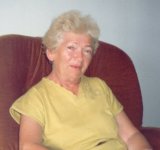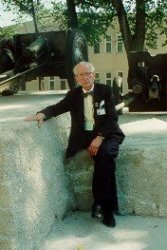Shell in the "Adria"
On 18 August 1944, the building at 8 Moniuszko Str., which housed the insurance company "Runione Adriatica di Securia" on the upper floor and the exclusive café/ballroom "Adria" on the lower and cellar floors, was hit by a gigantic shell, which, fortunately, did not explode.
And this is how Halina Auderska, pseud. "Nowicka," at that time the war press reporter for the AK Office of Information and Propaganda, remembers the incident.
"I was standing at the window on the fourth floor watching the aeroplanes circling above the PKO and the "Adria." They were attempting to localise the radio station "Blyskawica" using goniometric bearings. It was extremely hot on this unforgettable day. (...) Suddenly, the building began to rock and everything turned white from the falling plaster. I saw a huge bomb shoot through the fourth floor wall opposite us and continue over the courtyard, heading directly for me. (...) It had almost reached me when, suddenly, it plummeted down onto the "Adria" dome. (...) I was so shocked at what I had just seen and at the fact that it had missed me, although it was apparently inevitable, that I did not move in spite of crashing walls and shaking house. I remained standing at the window, rubbing the dust from my eyes and shaking it from my hair. Suddenly, someone in the courtyard began shouting: "Everybody come down! A time bomb. Could go off! Come down!"
I ran to the door but there was no longer a hallway behind it: I was ...facing a newly made crater, at the edge of which lay a wounded boy, writhing in agony. (...) Only with the help of an insurgent who appeared, could we bring the wounded boy and ourselves a floor lower and that with difficulty."
The above quote comes from an unusually interesting article by Halina Auderska titled "The Dancing Shell" which appeared in the Warsaw weekly illustrated magazine "Stolica" nr. 1 on 3 Jan 1971.
Halina Auderska also mentions other witnesses' experiences during this incident, including Jacek Wolowski "Zygmunt" who was thrown to the ground by the impetus of the air, and Aleksander Maliszewski "Piotrowski" who was downstairs at the time.
Below, a fragment from Aleksander Maliszewski's recollections as cited by Halina Auderska.
"We're sitting downstairs in the canteen - quiet and empty. St. R. Dobrowolski comes in, sits down and falls asleep. The light flickers and, above, the sound of crashing floors increases, a thud - I see an enormous slab of wall slowly approach us. It is moving so slowly that I have time to pull "Ela" under the table, push Dobrowolski and duck myself. The tinkle of breaking mirrors, a thick, milky air fills the room, you cannot see anything, silence, shrieks, silence, shrieks, silence - (...) Wounded are being carried in, six, two have been killed."
As soon as the first shock had been overcome, German captives were brought in to find out more about the explosion. Unfortunately they were so shocked; they could not provide any information.
Lieut. "Steb," "Tygrys" - Stefan Berent - commander of the printing works guard division found the appropriate tool to remove the detonator and the actual work was done by "Pillert" engineer Eugeniusz Dutkiewicz and "Szczepcio" - Szczepan Gorzkowski. The shell was disarmed.
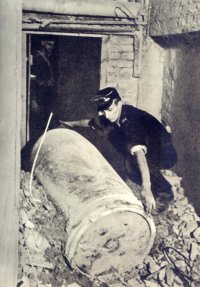
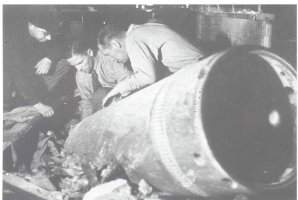
Lieut. "Brok" - Eugeniusz Lokajski immortalised the whole action on film. Stefan Berent remembered the detonation as follows (we are citing Helena Auderska):
When "Pillert" began removing the detonator a characteristic hissing sound could be heard. Everybody froze and "Pillert" ceased working for a moment, but started back again. He supposed the hissing was caused by air suction. A moment later, he was holding the detonator in his hand."
After the detonator had been removed, the explosive material was removed from the actual body of the shell. It turned out it was many times more potent than trotyl. "Pillert" suffered poisoning during the action.
Why did the shell not explode?!!!!!
It was used to destroy heavy metal and concrete fortifications but hit a café. After the Uprising, many stories circulated and one had it that a note was found inside it, written in Czech, stating "this shell will not explode."
The explosive material removed from it was sent to the grenade factory at 2 Boduena Str. where it was made into "sidolowki" (detergent cans filled with explosive material and used during the Uprising) by women sappers belonging to the group "Bombs": "Iza" - Wanda Wagner née Maciejewska, "Hanka" - Irena Grabowska, "Ada" - Eliza Sznajder, "Alka" and "Baska" - Barbara Wysiadecka. And so it returned to the Germans as most unpalatable food.
After the shell had been disarmed in the PKO building, instructions appeared on a wall of the room occupied by the commanding section of "Kolegium B." The content is described by Jerzy Filipowicz in his book "I was 14 at the Time." (PAX 1972):
"Calibre 600 mm, length 2,100 mm, weight approx. 1,500 kg. Range, several dozen kilometres. Cannon mounted on a special platform. Firing recurrence, around 4 times an hour. High-trajectory weapon. Apparently it is visible when changing its firing direction. Detonated with the help of special explosive cushions."
On 20 June 1964, during the preparatory excavation work for the east wall on Marszalkowska Str., at 8 Moniuszko Str., the hull of the shell was found - the shell that landed on the "Adria" dance-floor, on 18 August 1944. The Warsaw Detonation Group was called and the sappers, led by Lieut. Michal Sawczyc, removed it from its resting place. Today, it can be seen in the courtyard of the Polish Army Museum in Warsaw.
Many legends, both documented and narrated, surround the cannon and shell, which hit the "Adria" and, to this day, it is still very much alive in many people's minds. In numerous photograph albums dedicated to the Warsaw Uprising, a flying bomb is depicted and described as a shell ejected from the heaviest of rail cannons. The same is portrayed in the "Braun" photograph, which shows the moment the heavy shell exploded in the Prudential building and is also described as a rolling cannon explosion.
The rolling cannon - the myth behind Big Berta
In her reliable article concerning the truth surrounding the circumstances of the "landing" in the "Adria," Halina Anderska also refers to the shell as one from a rolling cannon. The article met with a large public response to include Eugeniusz Lokajski's sister, Zofia Domanska, and one of the "Bomb" members "Baska" - Barbara Wysiadecka who filled the "sidolowka" (can normally containing a cleaning agent but during the Uprising filled with explosive material) with explosives removed from the unexploded "Adria" shell. The lengthy article titled "Cannon Dialogue Input" written by Col. Janusz Przymanowski (Stolica Nr. 4, dated 24 January 1971), a much esteemed soldier, journalist and historian, evoked a number of reservations. Col. Przymanowski states the date of the "landing" as 7 August, but 18 August is, undoubtedly, correct. This is further upheld by the fact that German documents state the cannon used in the "Adria" incident was first used by them on 18 August.
With reference to Helena Anderska's article, Col. Przymanowski acknowledges the "Adria" shell to have been fired from a rolling cannon and draws parallels with the so-called "anti Paris cannon" also called "Big Berta," which was used by the Germans to bomb Paris during WW1. He describes its characteristics and options and, additionally, mentions the bombing of Great Britain, using heavy artillery, by the Germans over the English Channel.
He then goes on to describe the bombing by the heavy German artillery during the night of 14/15 August of the Warecki-Magnuszewski bridge-head. At that time, Col. Przymanowski was second-in-command of the 152 mm howitzer command. The surveying command determined the location of the German cannon and Col. Przymanowski depicts it as follows:
"Two heavy artillery units: 1st. and 5th. worked out the plans for firing and three volleys blasted from 72 guns. In the morning, spotter planes photographed destroyed rail tracks, an overturned platform and a mighty long gun-barrel torn from its bearing."
He continues, saying that based on the fragments of the heavy shell found near their own location, that it was a 620 mm calibre and that he reconstructed it to define the profile.
Further on in the article he writes:
"This monstrosity appeared on the outskirts of Warsaw - I don't know if it was the one which had been restored or another of the same calibre" - says Col. Przymanowski, with reserve.
And then the author describes anecdotally the, probably, final destruction of the monstrosity.
As we have already mentioned, the rolling cannon also plays a role in the various documentations pertaining to the Warsaw Uprising. In his documentary book titled "The Warsaw Uprising 1944 - an outline of the activities from the army perspective" (2nd. edition - PAX 1964), whilst discussing the German attack on Sadyba on 2 September Col. Adam Borkiewicz writes:
"Also heavy tanks and mortars took part" (attack - our footnote - H.K. and M.P.)
Further on he describes Sadyba's last moments, based on accounts by Witold Zenowicz, Kamil Aszkulajtis and unknown liaison members, all of which are incorporated in the Acta Ocupationis Germanica:
"Those who had been cut off hid in the fort where resistance lasted till 14:00. A shell fired from the heaviest rolling mortar in Neonowek burst through the fort's old casemate vaulting where the staff and stretcher-bearers were. The fort commander, Capt. "Jaszczur" and 21 soldiers were killed and the dressing-station together with the staff and wounded, whom it had not been possible to transport to the hospital, were buried in the rubble."
Leslaw M. Bartelski in his documental book "Mokotow 1944" also writes about the attack of the heaviest rail mortar, calibre 610 mm, which was located near the village of Dabrowka by Pyr. He also includes a photograph of the 42 mm calibre, "Gamma Moraer" set on a stationary base at the moment of firing.
Piotr Stachiewicz also writes about the heaviest of mortars in the book titled "Umbrella" (PAX - Warsaw 1981). In his OOB (Order of the Battle) account of the German forces attack on Czerniakow from the Sejm (Parliament) area in September he writes:
"The air force bombers, batteries of air mine throwers and the heaviest of mortars 600 mm calibre, set upon a train under-carriage (our footnote - H. K. and M. P.) and located in Wlochy, worked together with the groups (meant are the German groups - our footnote - H. K. and M. P.)"
A string of inaccuracies and mistakes appear in the above quoted accounts and descriptions and, in some cases, there are overlaps.
The following ought to be noted:
The Germans did not use the rolling cannon against the insurgents. Von dem Bach, in his account given in 1947, maintains that the German rolling mortar on the Warsaw-Radom line was not used against the insurgents. On the other hand, Hans von Kranhals in his book "The Warsaw Uprising" (Frankfurt 1964) cites witness' accounts (most likely Col. Borkiewicz) and undermines von dem Bach's information, stating that a shooting mortar was seen around Neonowek, by Piaseczno.
Confusion of names and topography - there is no such place near Piaseczno as Neonowek. It is most likely Neonowka, where, indeed, there was a rolling cannon firing the front-line behind the Vistula. As to the location of the mortar around Pyr, this will be discussed later.
A self-acting mortar indeed
Based on documents and preserved relics of the mortar which hit the "Adria" and those of another missile of the same calibre, which was found after the war in the Warsaw ruins, it can be deduced that the Germans used a 600 mm mortar, "Karl-Gerät 040" during the bombing of Warsaw in the Uprising.
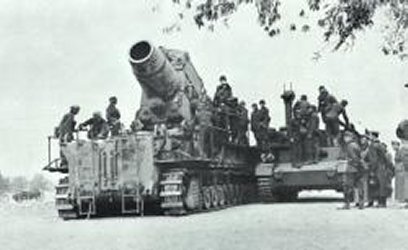
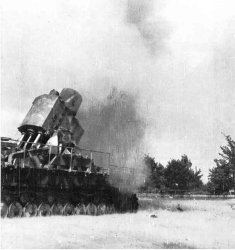
Mortar 600 mm "Karl-Geraet 040 in action
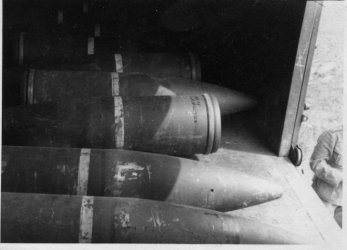
Ammunition for a heavy mortar
Only seven mortars were produced in the years 1939-1941. It was a high-trajectory weapon with an angle of elevation of 500 to 600. The barrel measured 98.5, was 5,068 mm long and threaded. The barrel's recoil length was 920 mm and mount length 780 mm. The mortar had its own traction in the shape of a special caterpillar undercarriage creating its own characteristic frame and measured 16 m. When the mortar was about to be fired, it was lowered using a special mechanism so that the base was set on solid ground. Only then was it able to fire. The actual mortar weighed 68,000 kg and together with the undercarriage, 120,000 kg. The shells weighed 2,200 kg and reached a starting speed of 220 m per second. The flying missile could thus be seen in the air. The mortar was loaded from a special crane/lift mounted on a tank undercarriage, Pz. Kpfw.T. VI (Panzerkampfwagen) "Tiger", made of cast-iron. With the help of self-acting traction, it could travel 5 kmph. Due to the weight of the mortar, it could only travel along hard ground, without obstacles. The rapid-fire capacity was 6 shots per hour and the maximum range 6,800 m. It was manned by 110 soldiers, under one officer.
The mortar mirrored Hitler's giantomania as well as his dilettantism. When approving the production of this giant, Hitler was, most likely, thinking of Frederick the Great, who was his unattainable ideal. Bearing in mind the heaviest artillery, Frederick the Great said:
"Not only the number of dead counts in winning a battle but also the fear a weapon stirs up among the living."
During WWII, this type of mortar was used for the first time during the siege of Sewastopol, but with little success.
As has already been mentioned, "Karl" was first used in Warsaw on 18 August. The shell, which hit the "Adria," was probably the first one to be fired in Warsaw. In the German 9th. Army documentation, this mortar is mentioned for the first time under a 20 August entry. It makes up the - 638 Battery - Mortar 61 cm." It is described as a reserve in von Bach's corps group and assigned to individual sections on the front-line, according to need. The mortar was to be used to destroy heavy fortifications but its implementation in the Uprising only demonstrated amateurishness. It proved impractical for city- street battles and confined areas with restricted movement, a conclusion drawn by the Germans themselves and proven in practice.
Theoretically its rapid-firing was 6 shots per hour, but due to the obvious transportation problems, the Germans probably did not have too many missiles. It can be estimated they only fired as many missiles as the ammunition wagon could hold, namely six.
Apart from destroying a few buildings and the obvious loss of lives, the mortar did not live up to the Germans' expectations. Fact is, the insurgents fought on for another 45 days after the first shell was fired from the mortar.
"Karl's" firing location
Taking both into account, the first landing point of the missile i.e. the "Adria" and "Karl's" range i.e. 6,800 m - it is here, within this radius of the "Adria" that the location should be sought.
Wlochy, suspected of being the location, is within this radius when considering the first missile, which landed in the "Adria" but a radius of 6.800 m also takes in Mokotow, but not Sadyba.
Taking into account the aforementioned characteristics of "Karl," one ought to exclude the possibility of firing from a rolling base. Due to its technical aspects, this was impossible. It was loaded from a special crane lift and this would only be possible if it was on the ground, not on tracks. Reliable witnesses, who located it in Wlochy, saw it on a truck. The extremely heavy mortar could only move very slowly and had to be transported on a special rail truck, even to a nearby shooting range.
As far as "Karl" being used to fire on Sadyba - this district was absolutely not fired upon by this type of mortar. The co-author of this article (M. P.) survived the capture of Sadyba and the fort. He also survived the German air raid. Beyond any doubt, the fort command perished from a bomb thrown by the Germans. After the Germans captured the housing estate, Sadyba, a number of unexploded bombs remained wedged in the earth. They had been destined to destroy heavy fortifications. No heavy shells resembling "Karl's" were among them. They were not removed until March 1945.
Not only "Karl"
Apart from "Karl," the Germans also utilised another type of heavy mortar, namely the 380 mm calibre type, built on a tank undercarriage. Pz. Kpfw. T. VI "Tiger" made of cast iron.
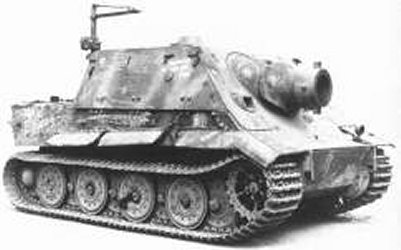
Mortar 380 mm "Sturmtiger"
During the years 1944 and 1945, between 12 and 18 were built. It was commonly known as the "Sturmtiger." Its reach was 6,000 m, weight 345.3 kg and beginning speed 91 m per second, at which it could be discerned during flight. Its rapid-firing range was 3 shots per hour.
In the German 9th. Army acts, regarding von Bach's OOB Corps Group, on 14 August 1944 the following information is noted: "at the entrance there's a Tiger with a 38 cm rocket launcher." And in a document dated 20 August there is mention of the Storming Mortar Company Nr. 1000, which included 2 army wagons with 380 mm guns, 2 officers and 54 soldiers.
According to Sgt. "Rudy" (Jerzy Sienkiewicz), on the day the Uprising capitulated, one of those mortars was located at the crossroads of Sucha and 6 Sierpnia St., not far from the filters. This information is worthy of belief. Considering the streets were full of obstructions i.e. barricades, filled with rubble and full of craters it would have been almost impossible to move. As the mortar had a range of 6,000 m, it was possible for the Germans to fire at all insurgent points, excluding the Kampinos group. Here we must note that the area around the Sucha St. is not far from the Dworzec Zachodni, which had to be the point the Germans used to unload their equipment.
Once more about the rolling cannons
In spite of the fact that the Germans did not use the rolling cannon against the insurgents, the legend surrounding them or, more correctly, surrounding the rolling artillery contains a grain of truth. Namely, the Germans had 2 armour-plated trains with their own artillery, in Warsaw, one of which was train Nr. 75, a training train.

Armour-plated train nr. 75
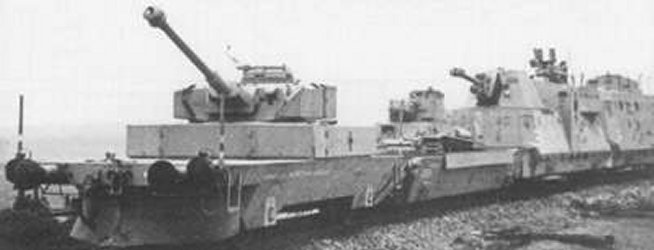
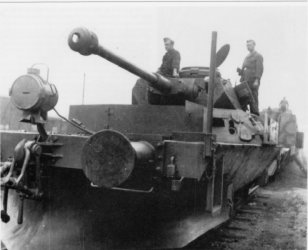
A fragment of the armour-plated
It was equipped with 18 machine guns, a 105 mm howitzer battery and manned by 48 soldiers under 1 officer. It is mentioned in the 9th. Army's documentation pertaining to von dem Bach's s OOB Army Corps, Reinefarth's group and in Col. Willi Schmidt's shock troops, all dated 6 August.
In the acts, dated 6 August there is a note referring to the conversation, using the David E. Hughes apparatus, held at 14:06 between SS Brigadefuehrer Kaminski and Heinz Reinefarth. The content is as follows:
Kaminski to Reinefarth: "The armoured train is causing chaos and shooting my Frotow regiment."
The armour-plated train nr. 75 fired in Wola, Powazki, Stawki, PWPW (national Mint) and the Stare Miasto. In a document dated 14 August there is a remark as to it having been moved to Lowicz on that day. However, it is mentioned again in a document dated 20 August, stating it to be by Schmidt's OOB shock troops.
Moreover, in the same acts dated 26 September there is mention of the armour-plated training train Nr. 5 at a group of units in the "Kampfraum Warschau." It is most likely this train's artillery fired around Jaktorowo and broke through the "Kampinos" group on 26 September.
So Col. Przymanowski is partially accurate
As ensues from the German 9th. Army acts dated 3 August, in the OOB of the 17th Infantry Division there is the 8th. Rail Battery, with 105 mm calibre cannons. Further documents mention it on 6 and 14 August and, on the other hand, on 26 September it falls directly under the VIII Corps.
From the next 9th. Army OOB, dated 14 August, it is evident that on the section "Harko 307" there was the nr. 679 Train Artillery Detachment with batteries 686 and 695.
Which rolling cannons were at the Germans' disposition?
According to Stefan Pataj's exhaustive artillery catalogue ("Land Artillery 1871-1970" - Warsaw MON 1975) between 1918 and 1939, the Germans had 6 types of rolling cannons with calibre 149.1; 172; 203; 211; 238 and 283 mm, with a maximum range between 22,500 to 45,000 m. Between 1939 and 1945 they had 3 cannon types, calibre 283, 380 and 800 mm, maximum range between 46,000 m and 55,700 m.
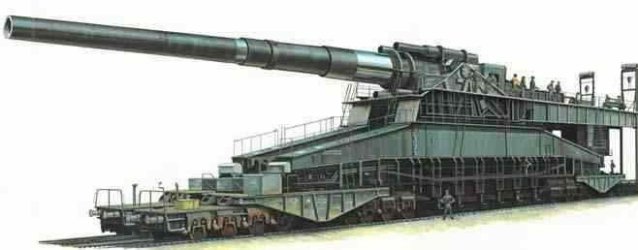
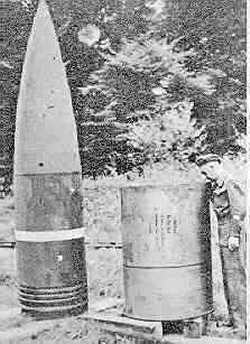
Rolling Cannon Dora and ammunition
It should be emphasised here that the shells for the rail artillery were flat-firing. Due to their wide range, they did not fulfill their function in a built-up city, where the front-line was complicated, often running through and through one district. It was futile to use the wide-range flat-firing cannons. The fighting often took place over areas, which were either held by the insurgents or the Germans.
Col. Przymanowski recalls assembling the fragments of the large shell. True, in the 9th. Army acts, dated 26 September, there is mention of an Artillery Battery equipped with the "Gerät 040 428." Consequently it must be the mortar belonging to the "Karl" and "Thor" series, calibre 428. As for the description "Gerät 040," maybe a mistake was made in the entry. "Gerät 040" describes mortar of 600 mm calibre, it is possible that 42 cm "Gamma Mörser" is meant, as is noted in the symbol ending. This mortar had a range of 14,200 m, shell weight 1,020 kg and opening speed 452 m per second. This type of mortar is also mentioned in Leslaw M. Bartelski's book. Bearing in mind that Pyr is located on the Warsaw-Radom route, it is possible it was seen in this area whilst being transported.
Which shell did Col. Przymanowski reassemble? Was it the one from "42 Gamma Mörser" or from the 800 mm calibre, Dora? This remains a mystery. It is worth mentioning that the unexploded shell is on display in the courtyard of the Polish Army Museum. It was found on Polish ground. Did that cannon fire the Warecki-Magnuszewski bridgehead?
In spite of all, there are still many puzzles concerning WWII, which are still awaiting a solution.
Hanna Kuczmierowska
Maciej Piekarski
Although many decades have past, "souvenirs" of the Warsaw Uprising 1944 are still being stumbled upon.
On 8 June 2007 at 10:30 on a construction site in Bagno Str. workers found a 580 mm calibre unexploded bomb, weighing approximately 1.5 ton. It was almost a metre beneath the surface of the earth.
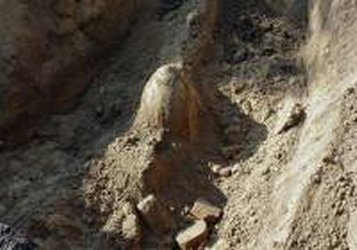
Unexploded shell of a heavy mortar
Police evacuated 600 people from the 6 neighbouring buildings. At around 14:00 sappers arrived, cautiously removed and transported it to a firing range near Warsaw where it was deactivated. For several hours, the streets around Grzybowski Square were secured by the police.
elaborated by Maciej Janaszek-Seydlitz
translated by Jolanta Jurasinska
Copyright © 2008 SPPW1944. All rights reserved.
